Before this week’s main event on why vintage collectors prefer originality, a few thoughts on Bulgari, Zenith, and LVMH. Then, a look at Yves Saint Laurent’s Cartier. After that, more on Timex, Capybaras, and watch events. If you’re new, check out Unpolished’s archive.
Bulgari’s big release at LVMH Watch Week was the Serpenti Automatic powered by its new BVS 101 movement. Zenith will begin producing the caliber and make it available to other LVMH brands.1 Rather than acquiring a movement maker as had been rumored, it seems LVMH is taking the DIY approach. Perhaps it also makes sense if things are slow at Zenith, a possibility if last week’s notes about Jaeger-LeCoultre are any indication.2
It’s easy to be skeptical of the world’s biggest luxury conglomerate throwing its weight around. But, things are slow in Switzerland, so I’ll take it as a positive sign that LVMH is investing in watchmaking. Plus, a compact new movement might mean more wearable watches from TAG Heuer, Zenith, even Hublot? More on LVMH’s earnings below.
🐍 That Serpenti Auto is cool, but it’s no match for this manual Vacheron Constantin/Bulgari Tubogas from the ‘70s with a tri-gold case:

Yves Saint Laurent’s Cartier Santos-Dumont
Sotheby’s is holding an auction of items from designer Yves-Saint Laurent’s collection ending on Jan. 30. Hidden in the catalog is his 1970s Cartier Santos-Dumont. Saint Laurent can be seen wearing the Santos-Dumont in moodboardy Vogue photographs from his Paris living room in 1971:
This is a gold Cartier Santos-Dumont ref. 78097 from the 1970s, part of the original Louis Cartier Collection launched in 1973 that brought designs from Cartier's golden years into regular production. Here’s my 1970s Cartier Collector’s Guide for more.
I haven’t done as much research on the Santos-Dumont as other ‘70s Cartiers, but it looks like at least 2,000-2,500 were produced, making it as rare as, say, the Tank Normale. Personally, I prefer the refined, thinner case of the later CPCP Santos-Dumont from the ‘90s—the 90th anniversary edition is one of the best modernish Cartiers.
Prices for a standard ‘70s Santos-Dumont sit around $10k, but Yves Saint-Laurent’s is already at €24,000.
Why Vintage Collectors Keep It Original
In the world of vintage watches, collectors speak reverently about condition and originality. The terms are thrown around so frequently that their meaning is lost amid a deluge of dealer listings and auction descriptions.
AND YET, countless conversations I’ve had with modern-pilled enthusiasts go something like this: “If I buy a watch that’s new to me [whether said watch is new or pre-owned], I want it to look new”—freshly polished case, clean dial, the works. “I don’t get this vintage thing!” they exclaim.
Vintage collectors aren’t great at explaining why they value original condition, “unpolished” cases, and unrestored dials. Waxing on about fat bevels and “but scratches are cool” only goes so far. After all, it was only a few decades ago that collectors didn’t care so much about originality—who’s to say tastes couldn’t change again?
Party Like a Rockstar
The best explanation of originality I've found comes from Dave Grohl. Recently, I read his biography, The Storyteller (get the audiobook he narrates). If you live in a cruel Sabrina Carpenter-induced haze of bubblegum pop and don’t know him, Grohl started the Foo Fighters after a stint as Nirvana’s drummer. In Storyteller, Grohl explores the beauty of originality—and maybe throws shade at Sir Paul McCartney?—more eloquently than any watch blogger could.3
He describes a backstage encounter with two aging rockstars who couldn’t be more different.
“One had the shiny appearance of a brand-new luxury car,” Grohl writes. "Perfectly dyed hair, spray tan, and a recently refurbished smile that looked like a fresh box of chiclets."
In a misguided attempt to freeze time, the rocker instead looked like a patchwork of past and present—part relic, part science experiment, with each tweak and tuck only making the contrast more jarring.
The other, Grohl says, looked more like a "vintage, burned-out hot rod," with “wirey gray hair, deep lines carved into a scowl, teeth that could’ve belonged to George Washington, and a black t-shirt that hugged a barrel-chested frame so tightly you knew he didn’t give one flying f*ck.”
“I decided right then and there that I would become the latter,” Grohl concludes. It was best to embrace the ensuing years and the natural toll they took. There’s something aspirational about becoming that burned-out hot rod, even if it requires a jumpstart every now and then. Not everything needs a shine.
Turns out Grohl would make a pretty good vintage collector/nerd. When collectors see a watch like this, they’re staring straight into the shiny, refurbished facade of that rockstar—veneers, spray tan, and all:

This vintage Daytona underwent a complete Rolex service and came out a bit of a patchwork of past and present. The lume plots at 3, 9, and 10 were replaced, with the later Luminova plots a few Crest Whitestrips brighter than the original tritium plots. It also has later hands and the bezel engravings were restored—compare to an original and you’ll see the font and lines look off.
The point isn't to knock the service or even the auction house (fwiw they disclosed all this and more)—it makes for a perfectly wearable, water-resistant Daytona if that’s your thing—but to show how one might see this Daytona like an aging, spray-tanned rockstar.
Real Original
Now, let’s look at a couple “burned-out” hot rods.
Last year, I featured this Patek Calatrava ref. 565 from a local auction. It came from the original owner, some Midwestern businessman. The dial and case are all original. The two-tone dial’s in excellent condition, even if the case has seen a polish or two. It still had soft hallmarks on the lugs and case, but it’d lost some of the muscular angles and square lugs that make a 565.
Yea, I’d seen better 565s. But you know what? I loved this watch. There was something about it. The caseback engraving. The non-Patek bracelet—just the way the original owner wore it.4
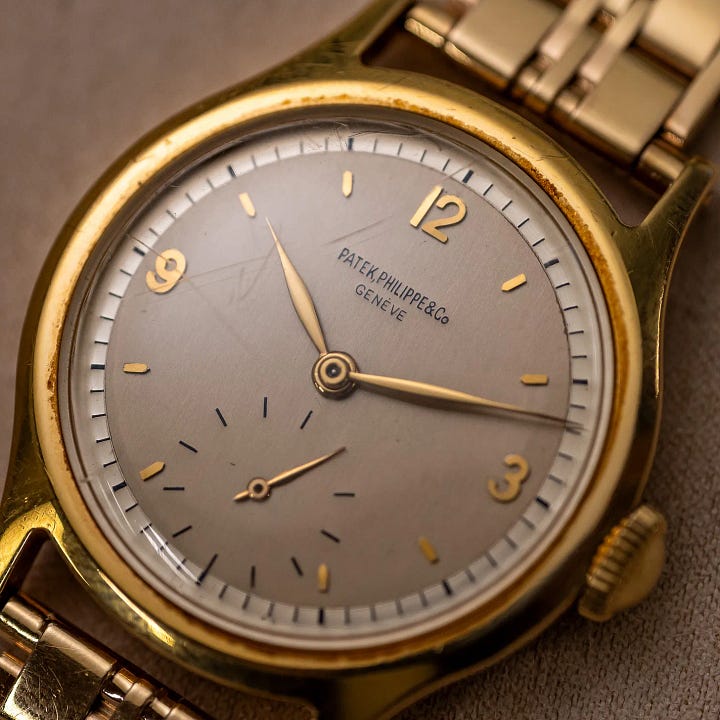
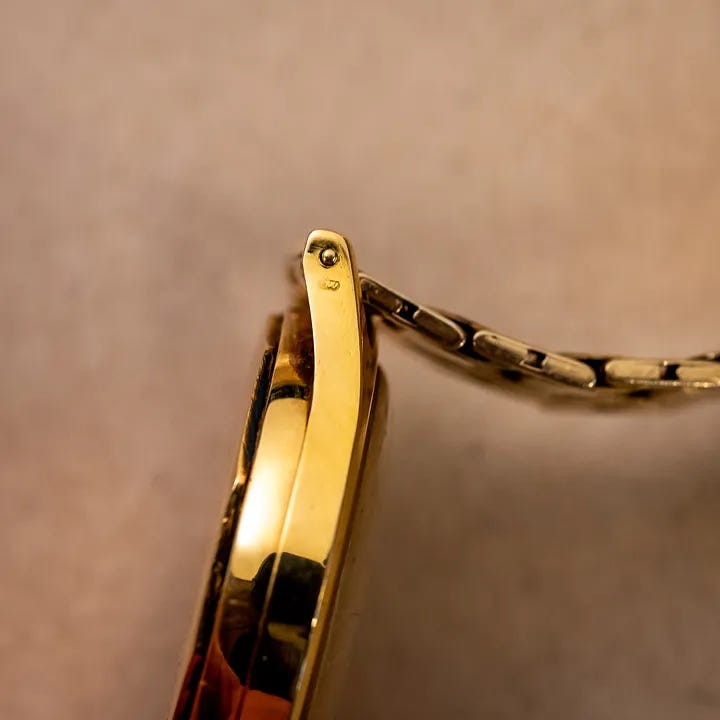
Whether an aging rockstar or vintage watch, it’s not about over-glorifying pristine, original condition for its own sake. After all, if you leave a watch in its box for 50 years, it’d come out looking factory fresh, with a gleaming dial and stickers intact. That’s fun to see once in a while, the same way visiting a museum to see the Mona Lisa or Crown Jewels proudly displayed behind a pane of glass is fun. But it’s not real.
Instead, if you take a watch out of the box, peel the stickers off, let it see the sun, soak up sweat, and live on your wrist, it’ll develop its own character—its own cuts, bruises, and scars.
That’s originality.
Sometimes it’s perfectly “unpolished” cases or tropical dials, but not most of the time. It’s not perfection, and it’s certainly not the gleam of polished-away scratches.
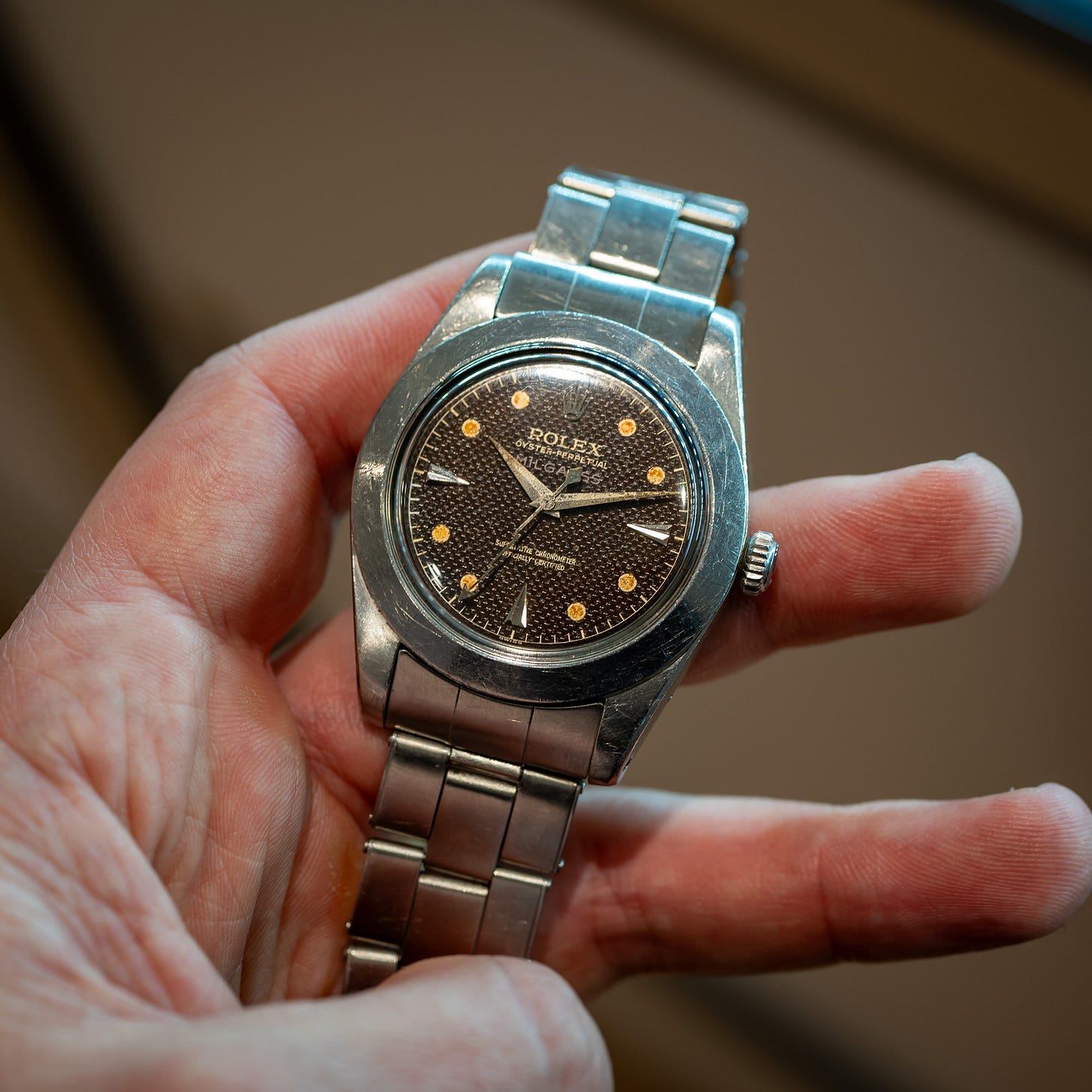
Sure, there’s a fine line between what’s acceptable and what’s not. Each polish removes a layer of metal, softening the stories and sharp lines that once defined a case.
But when a watch comes fresh-to-market from an original owner just the way they wore it, that’s the stuff. Maybe it’s seen a polish or two, but if it feels honest, I prefer that flavor of originality over the “perfect” vintage watch.
Mechanical watches are among the few objects we can own that last long enough to show these scars. When we find an original vintage watch, we're not seeing just how it was born at the factory—we're seeing how it lived.
So bring on the burned-out hot rods, with their wirey gray hair, scratched-up cases, and sun-faded dials that show decades of stories, of life, of originality.
The Roundup
🐍 LVMH Earnings. This week, LVMH reported record earnings for 2024, with a cool €10 billion in free cash flow. Revenue for its Watches & Jewelry division was down 2% in 2024, but profits were down 28%. LVMH said don’t worry, that’s because of “ongoing investments in store renovations and communications,” specifically mentioning Tiffany & Co. and Bulgari. The only watch brand singled out was TAG Heuer thanks to its return as the Official Timekeeper of Formula 1. For perspective, Watches & Jewelry together generate about €10 billion, 12% of the group’s yearly revenue (it doesn’t break down results by brands), about the same estimated annual turnover as Rolex. I’d imagine the massive luxury group sees watches as one of the few segments where it can still grow.
🪛 Watchmaking classes in Chicago. For locals, HSNY and Oak & Oscar are hosting watchmaking classes in February. I’ve done the class before and can say it’s a good time if you can swing the price tag. For the first time, they’re also offering the next-level class this year.
👏 Timex x Giorgio Galli Titanium. The new Giorgio Galli-designed Timex S2 is well done. Sellita movement, a now-recognizable, Polerouter-adjacent Galli design, and a titanium case with an interesting architecture and carbon midcase. At a time when many accessible brands are struggling, Timex is killing it, and small innovations like the case and no-tool link removal are examples of what much bigger brands should be trying. Limited to 500 pieces at $1,950.
🦫 How the Capybara won Gary Shteyngart’s heart—and everyone else’s. The watch world’s favorite New Yorker writer travels around the world to discover the internet’s favorite giant rodent.
📆 The Great Big Watch Calendar. I’ve been updating the Great Big Watch Calendar for 2025 with events that you lovely folks have sent in. Perhaps the biggest update is that Windup Fair dates are now set, with the Worn & Wound gang expanding to a fourth show this year, adding Dallas in March. Here’s the full, living calendar:
As always, comments and hearts below. This newsletter is a prelude to the next issue about Frankens. See you then,
Tony
P.S. I get many (mostly lovely!) messages by DM, Substack, and smoke signal. I’m most responsive by email so hit me up there: tony[at]unpolishedwatches.com.
P.P.S. If I’ve ever helped you find a watch or referred a client your way, no need to say you “owe me” or send a bottle of whiskey (that’s what those watch brands do!). Instead, just become a paid subscriber and support this newsletter:
There were rumors that LVMH wanted to acquire the Vaucher manufacturer, majority-owned by Sandoz Foundation (which also owns Parmigiani), who wants to get out of watches because it’s leaking money. LVMH Watchmaking head Frédéric Arnault denied this. It sounds like Hermés, which already owns 25% of Vaucher, is poised to acquire the rest.
Umm, we write newsletters now.
This is one of the reasons I enjoy doing the Watchlist and finding watches from smaller auctions and eBay. They often feel honest and original.






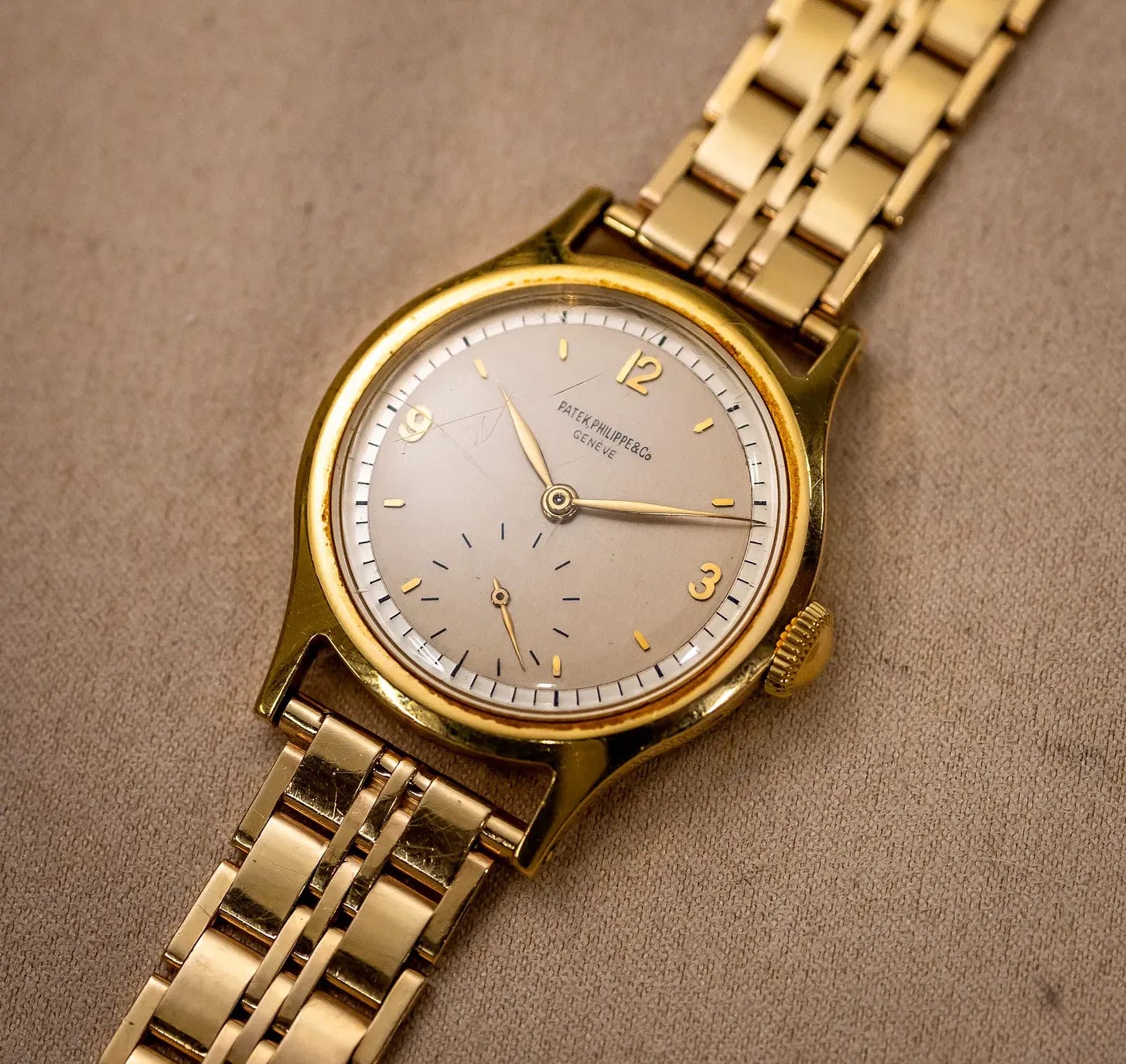

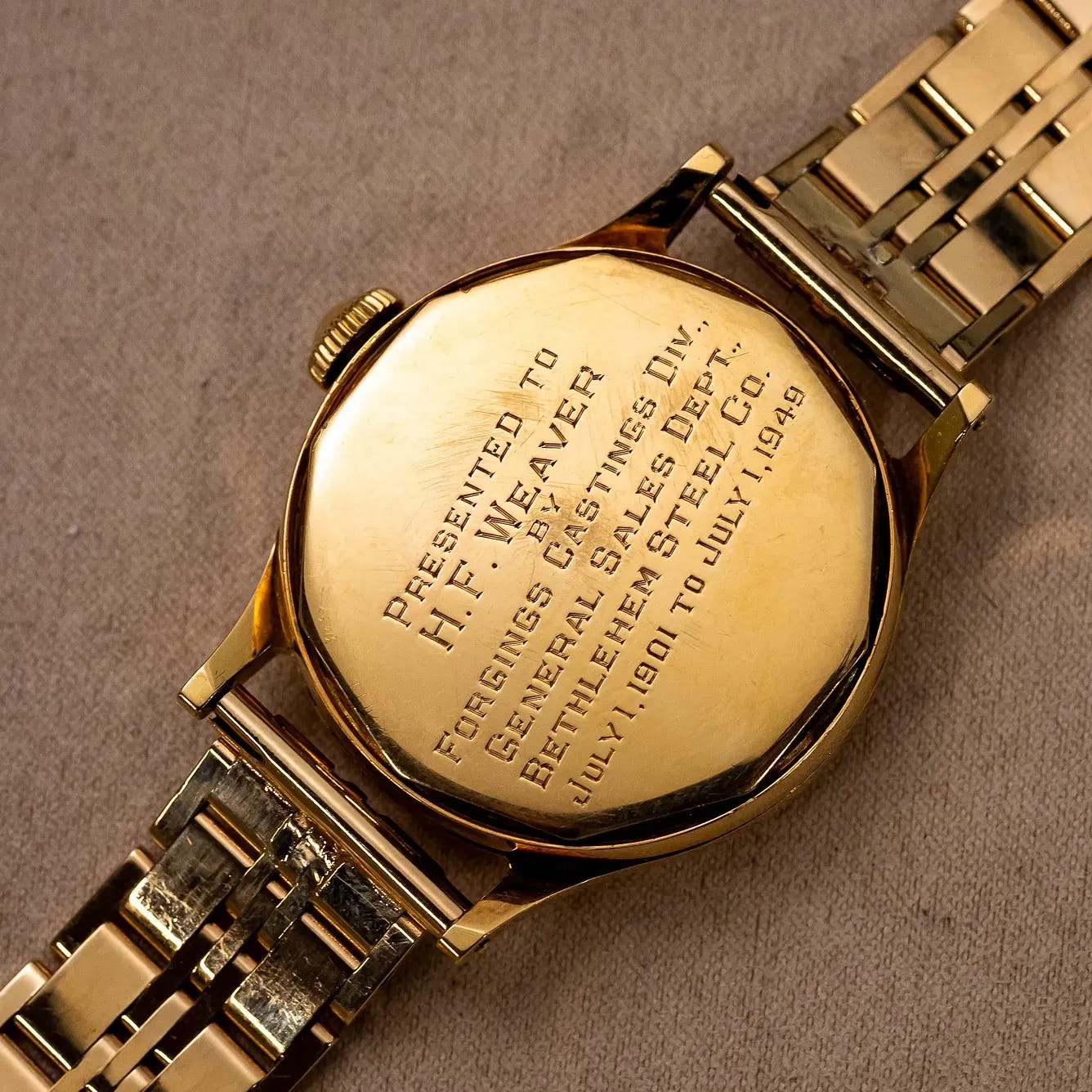

Good one.
The only issue with the Grohl analogy (and the analogy is solid) is that it only focuses on cosmetics. People and watches are machines. I am sure if Grohl needed a new hip or a new heart or a melanoma removed from his face that required a skin graft, he wouldn't limp around or let it met to his lung. He would get the new hip and the mole removed and get the skin graft.
The issue isn't really that unpolished/all original isn't the pinnacle. It is and should be. Unpolished all original doesn't need defending. It is fine right where it is.
The issue is that the dealers are directing the market and the market is broken because there is not enough attention to function for normies which makes vintage more difficult.
Maybe the focus shouldn't be defending unpolished/all original. Again - pinnacle, doesnt need defending.
Maybe the focus is segmenting the word collector. It seems that collector doesnt encompass the current zeitgeist which is why you are getting questions. Collector really addresses two distinct groups:
1. Archivist/museum curator - unpolished all original is entirely appropriate and really the only acceptable option. Watches rarely worn outside or day to day. Uber collector. Uber rare pieces, etc.
2. Normie vintage lover. Function is as important as original cosmetics. Running around with rotting lume worrying that it might crack is more of an issue than reluming. Swapping out a crown for a NOS or (gasp) aftermarket to get water resistance and keeping the original in a baggie for safe keeping is more important than worrying about an errant splash or humidity. These vintage watches are meant to be worn rather than put in a safe. This group of watches is also likely not super rare or even all that interesting in most cases. Just old.
Another possible way to help the situation is something along the lines of segmenting the watches. This sounds dumb but:
1. Vintage artifact/art piece. Modification is crime against humanity.
2. Vintage day to day. Modification helps function and is accepted/valued.
Basically this discussion is a market and marketing issue rather than an issue related to the value of unpolished/all original. In these discussions the different vintage types are talking past one another, perhaps, because they are talking about different things. The normie collectors need a market that also serves them. Right now there isn't any.
No idea if that made any sense.
Anyway - good analogy. Good newsletter.
Love the breadth…Patek to Timex